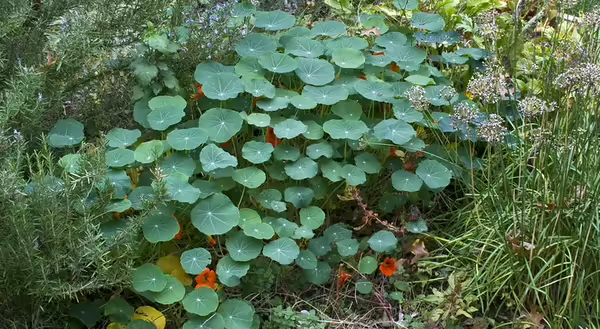
In late spring, a gardener walks out to their vegetable garden ready to collect a harvest, only to discover shot holes through kale and bites taken out of cabbages – even the tomatoes suffered, with many plants nursing broken stems. As the gardener returns to the kitchen, excitement for the morning harvest ends in disappointment.
Many vegetable gardeners and farmers experience the disappointment of pests pillaging a garden. Deer and rabbits consume tops off fruiting vegetables while cabbage loopers, aphids, and flea beetles chew holes in plant leaves. Perhaps accepting the reality of pests, some growers commit extra resources to their production by planting an overabundance of crops to mitigate their losses. Another option to combat pests, fight nature with nature. By planting marigolds, sweet alyssums, and nasturtiums, growers can lessen crop damage, create a beneficial insect refuge with insect allies, and grow a greater diversity of food.
Marigolds (Tagetes spp.) are both beautiful and strongly scented, and the plant’s pungent aroma can deter mammals. According to University of Minnesota Extension, their distinct odor can make them and their neighbors (the vegetables) unappealing to deer and rabbits, even in spring when flowers are not present. Add color to your production garden while reducing plant predation, with marigolds.
Sweet alyssum (Lobularia maritima) is grown not only as a carpeting flowering plant but also for its power to attract beneficial insects, like hoverflies and ladybugs. These insects are miniature cavalry in the garden – attacking insect pests that eat vegetables. Per Iowa State University Extension, some species of adult ladybugs can consume as many as 50 aphids per day. Plant sweet alyssum as a border plant around the garden to prevent aphid infestations.
Nasturtiums (Tropaeolum majus) are an easy-to-grow plant that adds unique color and shape to the garden with intensely hued flowers and round flat leaves that are reminiscent of lily pads on a pond. Although not a deterrent to pests, nasturtiums will attract hummingbirds and honeybees, according to the New Jersey Agricultural Experiment Station at Rutgers. And nasturtiums do more than benefit your garden, the leaves, and bright flowers, are edible – adding a pleasantly spicy and flavorful taste to salads. Plant trailing or compact varieties in the garden to benefit both you and pollinators.
A new future is possible. It is mid-summer 2023 and the vegetable garden looks superb. The deep green of foliage and light green of developing crop fruits are contrasted with three companion plant species: red and yellow marigolds, white sweet alyssum, and orange nasturtiums. Pollinators, attracted by the colors and scents, fly in and out, doing their incredible work. What is missing from this glorious picture? Crop damage by pests, and that is all by design.
Photo Credit: Nasturtium Fall Herb Garden by woodleywonderworks is licensed under CC BY 2.0.
ABOUT THE AUTHOR: Nick Frillman is a Local Foods and Small Farms Educator serving Livingston, McLean, and Woodford Counties. A fourth-generation graduate from University of Illinois, Frillman has a B.A. with a double major of Political Science and Spanish and a M.S. in Crop Science with a focus on crop production. Before joining Illinois Extension, Frillman completed a field season of CSA and farmers’ market-style production at a small “beyond-organic” vegetable farm in Sandy, Oregon.
ABOUT THE EDITOR: Liz Repplinger is the Agriculture and Natural Resources Program Coordinator serving Livingston, McLean, and Woodford Counties. A Bloomington-Normal native, Liz earned a B. A. in Animal Science and an M.S. in Animal Science from Illinois State University. She has enjoyed contributing to the multiple facets of Extension including previous support of the 4-H Youth Development Program as a program coordinator and current support of Unit and Statewide Diversity, Equity and Inclusion Initiatives.